What does silver poplar look like and how to grow it?
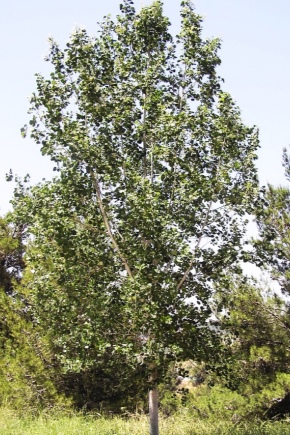
Poplars are the most popular trees, most often used as landscaping in large cities. Surely everyone remembers how the most delicate poplar fluff is carried from place to place by light gusts of wind in the July heat. And in the shade of its majestic crown, you can hide from the bright rays of the sun. In fact, poplar is a very interesting plant. It has many features, because of which it has gained popularity in landscaping.

Description
In the scientific literature on botany, the name populus alba is used. Scientists in conversation use the name of the plant "white poplar". And people who are not related to science call it simply snow-white or silvery poplar. In some literary works, the authors call this plant "Bolle's poplar" or "Bachofen's poplar".
Few people know, but in ancient Greek mythology, the white poplar was a sacred tree. Its branches symbolized victory, which is directly related to the overthrow of Kakus.
According to the teachings of taxonomy, poplar is a majestic plant, which is a fast-growing deciduous tree.
It belongs to the genus poplar and to the willow family.
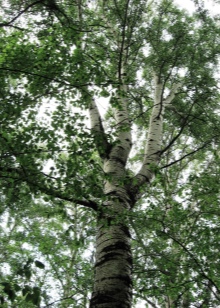

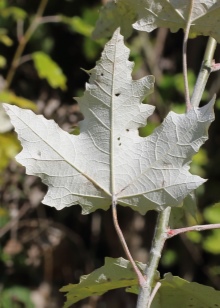
Distinctive features of white poplar are the thickness of the trunk, height, light color and crown, which can have a pyramidal or rounded shape. However, all representatives of the poplar genus look like this. Yet each species has its own characteristics.
The maximum height of the white poplar is 30 m. The wide crown is quite close to the ground, which makes the trunk seem rather short. In young poplars, the trunk bark is smooth to the touch. In adulthood, cracks of a silvery or greenish hue appear on its surface.
With the arrival of spring, the branches of white poplars are decorated with small buds, shaped like small grains. Foliage emerges from them. The structure of the open leaves is dense. From above, they seem to be filled with dark green paint. The shade of silvery felt prevails at the bottom. Around October, the leaves turn bright yellow, and with heavy rains they acquire a brown tint.
In different climatic conditions, poplar trees bloom at different times.
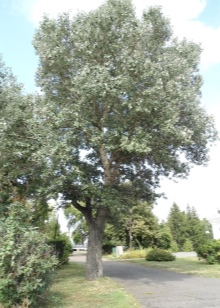
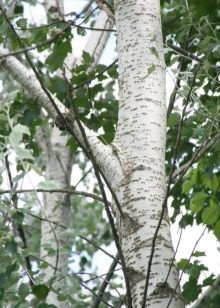
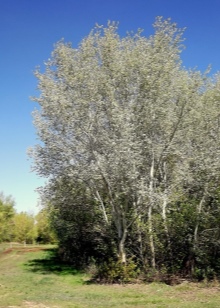
April and May are the time for the emergence of inflorescences, popularly called earrings. Their length reaches 8 cm. These earrings differ in gender. Men are gray, while women are dominated by a green tint. Initially, the tree blooms vigorously, and after the pollination process, seeds are formed.
The seeds, in turn, are shaped like a narrowed cone. At the first stage of development, they have a rich green color. And with subsequent maturation, the shade changes. Greens turn to light brown, and by the end of summer they become completely dark.
The main distinguishing features of poplar are vigor and vigor. Accordingly, such trees have a very serious root system, the development of which depends on the characteristics of the soil. Where there is high humidity, the roots are kept in the upper layers of the soil. And in clay and sandy earth they dig deeper in search of life-giving moisture.

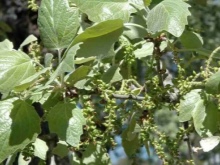
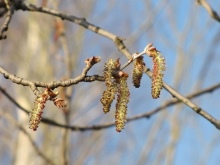
In addition to the features presented, white poplar has a number of additional characteristics. First of all, it is the height of the plant. Botanists claim that white poplars grow in nature, reaching a height of 60 m.However, for an urban scale, such trees are inappropriate. Accordingly, it is not possible for the inhabitants of the metropolis to see the silvery giants with their own eyes.
Starting from the state of seedlings, white poplar has been growing for 50 years. Further, their growth slows down, and after 15-20 years it stops altogether. The average life span of white poplars is 400 years.
However, when studying this unique plant, botanists came across specimens that were more than 600 years old at that time.
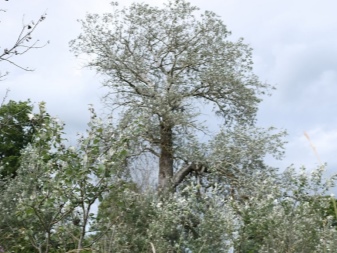
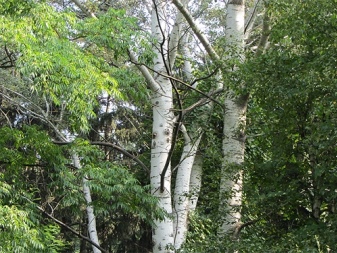
Overview of species and best varieties
Today, more than 90 plant species belong to the poplar kingdom. Some of them are wild trees. Others are artificial derivatives of breeders. The hybrids were able to contain decorativeness and resistance to unfavorable climates. Further, it is proposed to get acquainted with some types of poplars that can most often be found in the surrounding world.
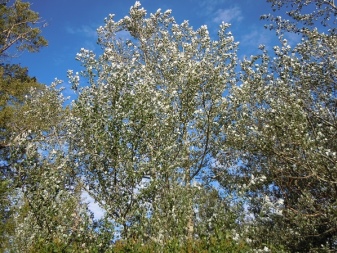
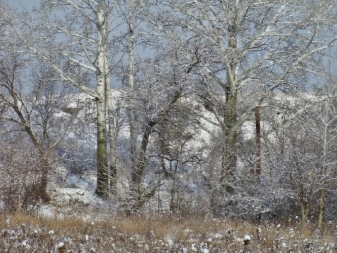
White poplar
This plant variety is most widespread in Asia and Europe. Its distinctive feature is a spherical crown, a short trunk and spreading branches, in which young leaves arise in spring, forming a densely flowering plantation.
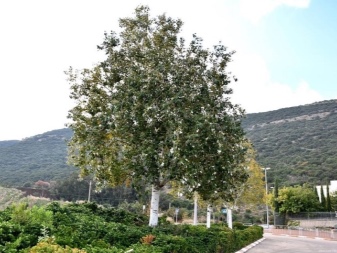
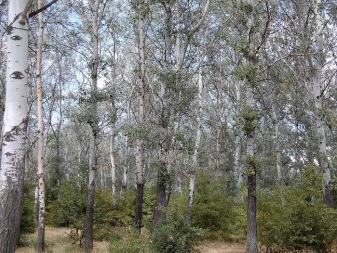
Canadian poplar
The brainchild of breeders, outwardly resembling a deltoid tree. Differs in height, spreading branches. The shape of the leaves is more like a triangle, the edges of which have small teeth.

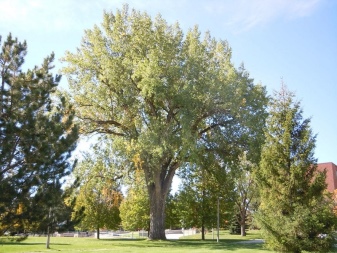
Poplar black
You can meet him in central Russia, in the Crimea, in western Siberia and, of course, in Central Asia. Black poplar is a powerful plant. It grows in light forests and on shores with loose soil. In adolescence, black poplars have a light gray smooth bark. However, over time, it darkens, cracks appear on its surface.
This plant prefers to grow in soil with a high humus content.
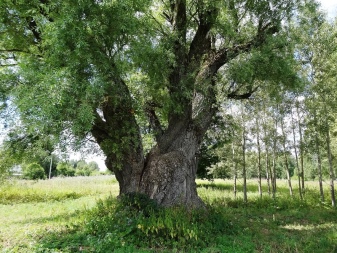
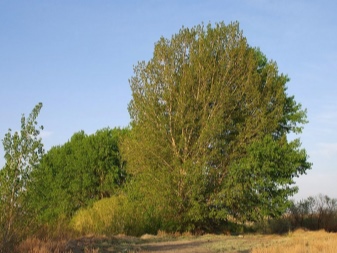
Sweet poplar
The most common plant in eastern Siberia. Its maximum height reaches 20 m; these trees are often used for arranging alleys and park areas. Large branches grow at an angle of 60-70 degrees, creating an oval crown with a diameter of no more than 15 m.
It is worth noting that this plant is unpretentious to the soil composition, however, it prefers chernozem and clay soil more.
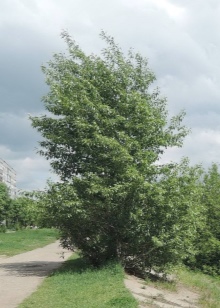
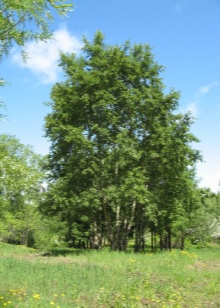

Lombardy poplar
One of the tallest representatives of the poplar family, preferring sunlight. The maximum plant growth is 40 m. The life span ranges from 300-350 years. As for the soil, pyramidal poplar loves neutral or slightly acidic soil more. Vigorous branches grow at a 90-degree angle to form a tapering crown. The surface of the bark of the trunk of the pyramidal poplar has pronounced small cracks.


Laurel poplar
This tree grows in Siberia. Its height reaches a maximum of 20 m. It prefers to grow in places where it can be sheltered from sunlight. A distinctive feature of laurel-leaf poplar is its rich green lanceolate leaves.
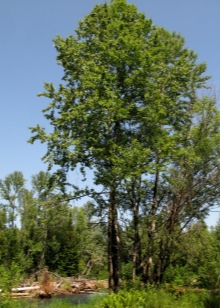
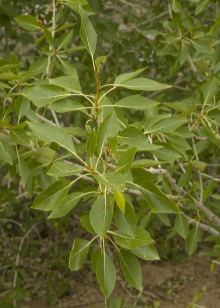
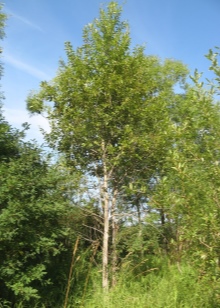
Poplar white "Raket"
A distinctive feature of the presented poplar variety is a columnar crown decorated with silvery leaves. Shoots grow vertically. The bark of young seedlings has a gray tint.
Often this type of poplar is used in landscape design.
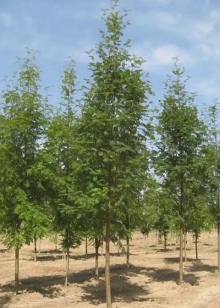
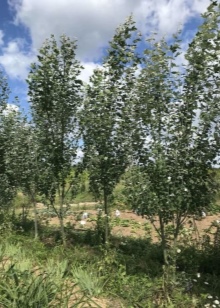

Landing features
To grow beautiful white poplars, you need to choose the right site for planting. Despite some of its fellows, white poplar prefers to grow more in places with free access to sunlight. Saplings planted on the shaded side will grow very slowly.It is imperative that there are no drafts in the selected area for planting.
It is best to plant seedlings in the spring. Those who believe that autumn is the best time for disembarkation are mistaken. Autumn plants have a weak immune system, which can cause illness and even die.
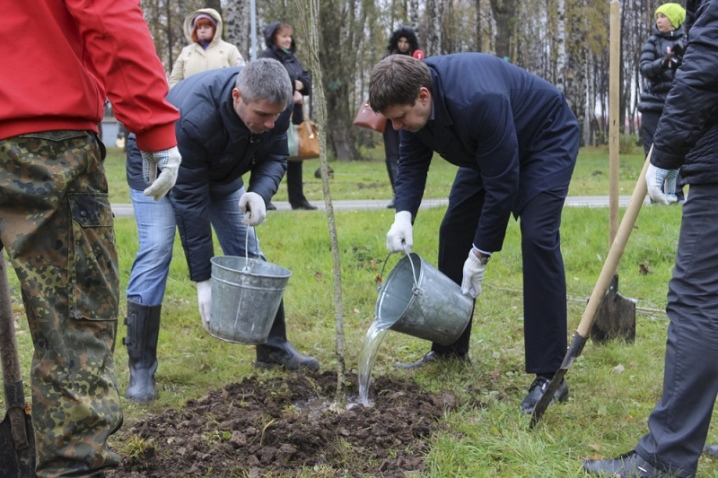
Primary requirements
Scientists never tire of asserting that silver poplar, or white poplar, takes root quite simply and easily in any land. These plants are frequent inhabitants of the subtropical, Mediterranean and temperate continental climates. They can grow anywhere in Eurasia, with the exception of Scandinavia. White poplars often grow near water bodies and near rivers in forest valleys. In the steppe zone, they prefer slightly saline soil. Well, if we are talking about rocky terrain, white giants grow at an altitude of 1000 m above sea level. At the same time, their root system is firmly held in the ground, encircling stones that go into the ground. Black poplar, elm, alder, tamarisk are suitable neighbors for silver poplars.
The best soil for planting white poplar seedlings is fertile soil with neutral acidity, good drainage and light substrates. And if you look from the other side, the white poplar is an unpretentious plant, it will be able to get out in slightly acidic and alkaline soil. He is able to withstand the aridity of sandstones and the severity of loam. It will draw moisture out of groundwater.
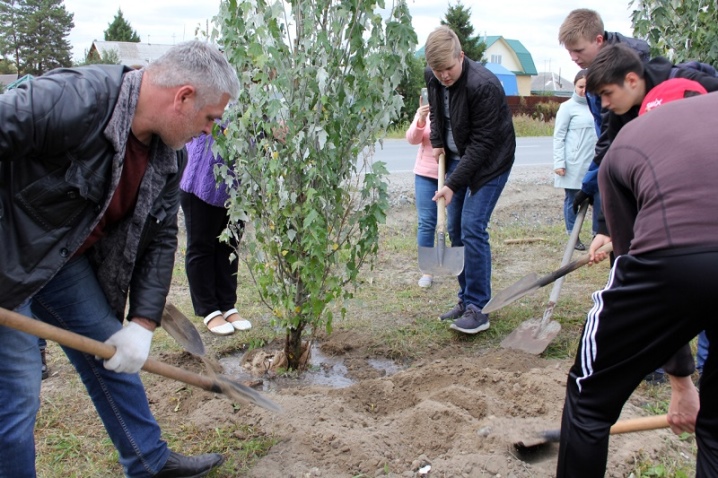
The white poplar breeder must pay special attention to light. This plant has a rather positive attitude to ultraviolet light. White poplars don't just love bright rays, they need them. Of course, if it is not possible to plant a tree on the sunny side, you can arrange its abode in the shade. However, this will slow down the growth of the plant.
Some argue that poplars are extremely picky about the cold. But it is not so. They cannot stand 70 degrees below zero. Well, in a standard Siberian winter, they live carefree for themselves.
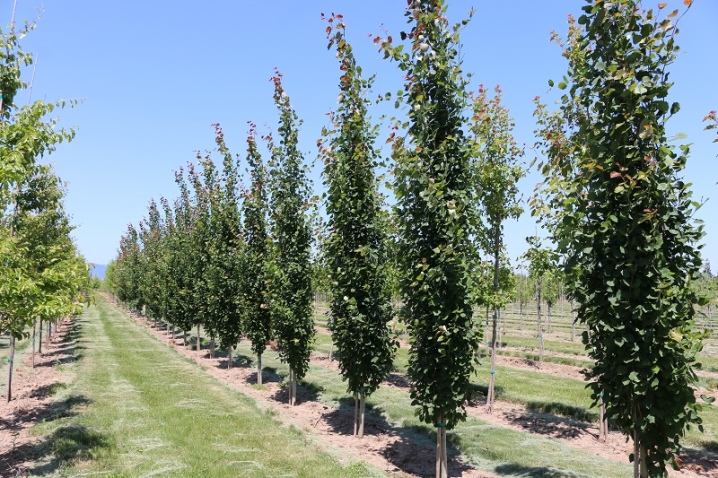
Technology
When planting young seedlings of white poplar, it is necessary to adhere to a certain technology. The distance between trees must be at least 1 m. The depth of the planting pit should have the same dimensional indicator.
A drainage layer is laid in the lower part of the harvested hole, thanks to which it is possible to exclude stagnant moisture. Afterwards, nitroammofoska or other universal fertilizer is introduced inside.
Next, you need to plant a young tree and secure it with a support. After disembarkation, the near-trunk circle is abundantly filled with water, mulching is carried out with peat or sawdust.

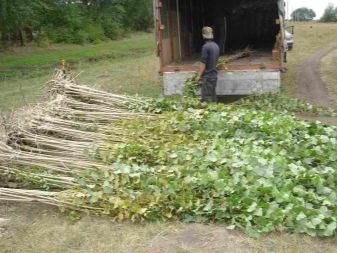
Care rules
White poplar is an unpretentious plant. It does not require any special care. It is enough to carry out standard agrotechnical measures, namely, timely water, loosen, cut and feed.
In early spring or late autumn, when the sap movement stops inside the tree, formative and sanitary pruning should be performed. Shaping allows you to get a beautiful crown of a neat shape. Sanitation must be carried out every year. It involves the removal of damaged, dried and dead shoots.
When the tree reaches the age of 35 years, it is necessary to carry out a rejuvenation procedure. To do this, you need to get rid of 1/5 of the plant from the top of the crown.
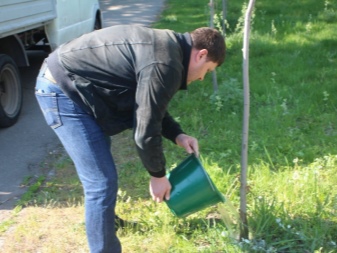
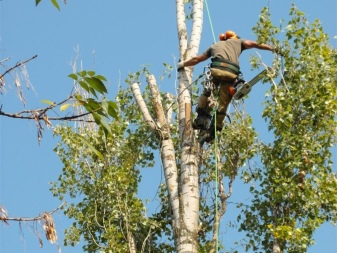
After each procedure, the trimmed areas should be treated with garden varnish. Then arrange abundant watering of the plant and apply top dressing. If the procedures are carried out correctly, after a while, young shoots will appear on the stem of the seedling, from which it will be possible to re-form the crown.
In the 1st year of life, white poplar requires frequent watering. For an agronomist, this procedure will not pose any problems, because the word "often" means 3 times a month. Water consumption for each seedling is 2.5-3 buckets. It is a little more difficult if a period of drought comes.If there is no rain, the frequency of watering should be increased.
1 year after planting, it is necessary to monitor the periosteal circle. Loosen this place regularly, remove weeds from it. The same is done after each watering. When the poplar reaches 6 years old, you can forget about the loosening procedure.
As for feeding, the first fertilizers are applied when planting seedlings. Further, on a regular basis, the plant should be supplemented with nitrogen-containing fertilizers.
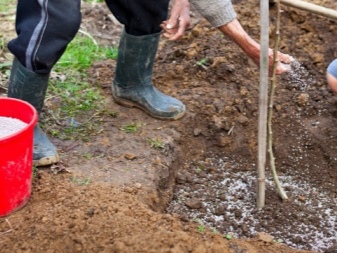
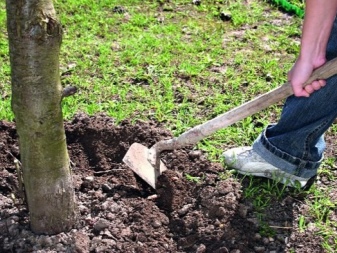
Reproduction
Since white poplar is very popular in landscape design, many agronomists have taken up its reproduction. Today there are 2 ways to increase the population of this beautiful tree - seed and cuttings.
The seed method is used extremely rarely, since in the process of work, agronomists can face many difficulties. As a result, there is a high probability that no shoots will sprout from all seeds.
But propagation by cuttings is a more affordable method of growing new trees. Young shoots quickly become entrenched in the ground. One-year-old twigs cut in the first days of spring should be used as propagated cuttings. Ideally, a twig 1 m long should be used. The main thing is that it has buds.
The harvested material is divided into several pieces, about 20 cm each. They then need to be rooted. The cuttings should go deep into the moistened soil - so that no more than 8 cm of the shoot remains outside.
It is recommended to root the branches in June, when the summer heat comes.
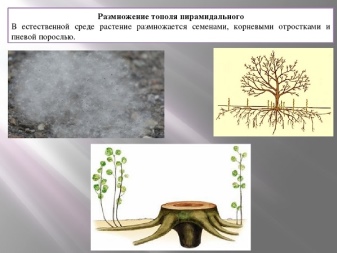
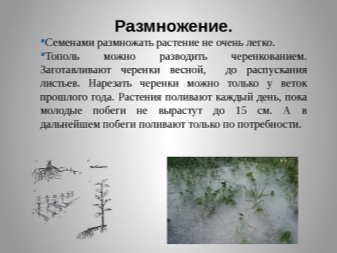
Diseases and pests
A distinctive feature of the white poplar is its strong immunity. But, despite this, even insects and some diseases can strike him:
- woody crayfish;
- necrosis;
- insects feeding on young foliage.
In each individual case, it is necessary to treat the plant with chemicals that can be purchased at any agricultural store.
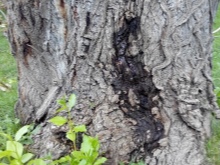
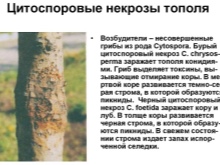
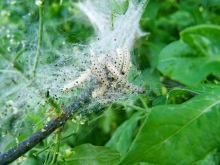
Application in landscape design
The splendor of the white poplar is characterized by a beautiful crown, thanks to which it is possible to create a pleasant shade on a hot summer day. In the form of group plantings, white poplars look extraordinary, especially if the poplar alley is complemented by acacia and juniper, which is comparable to the image of fabulous forests.
With the correct planting of seedlings, it is possible to create a hedge, thanks to which residential buildings are separated from highways and areas in summer cottages are delimited. What could be more beautiful than a dense green hedge 2.5 m high.
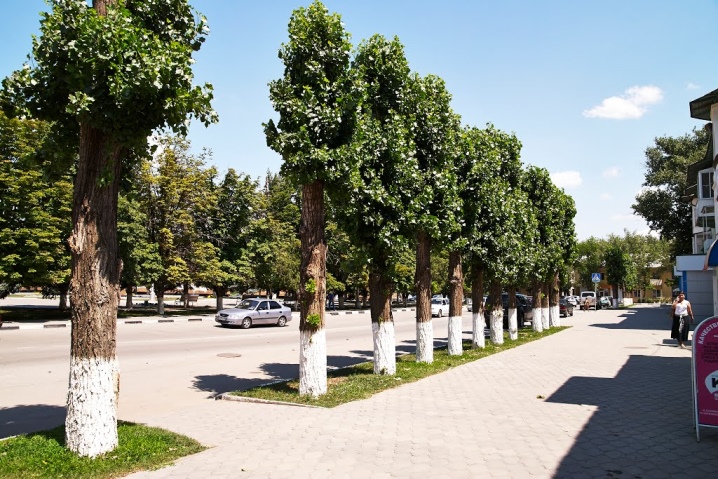
The only drawback of this beauty is the bare lower part of the trunks. That is why landscape designers recommend combining white poplars with low horticultural crops.
Many environmentalists are not installing metal or brick fences around office buildings, but green fences made of white poplars. Park zones and squares are separated by the same trees on an urban scale.
But it is no coincidence that white poplars are used when arranging the city's landscape. They not only create shade, but also give a light coolness that people need so much on a hot summer day.

You can learn how to properly plant a pyramidal poplar from the video below.



































































The comment was sent successfully.